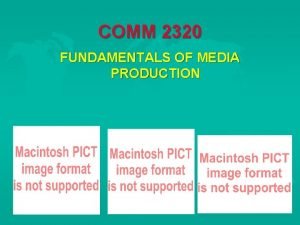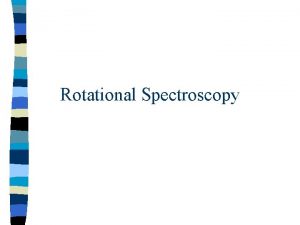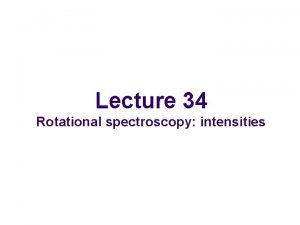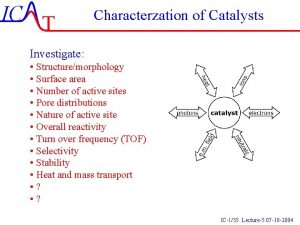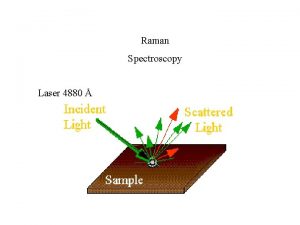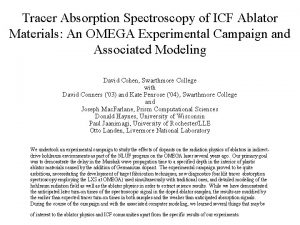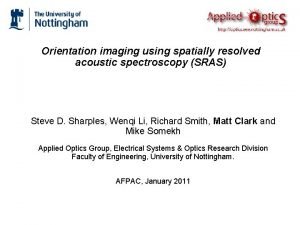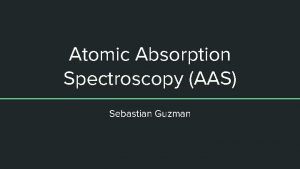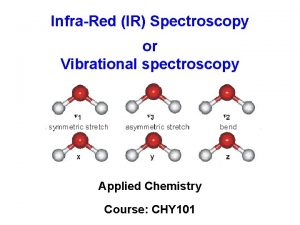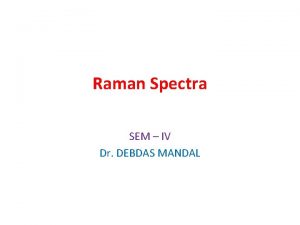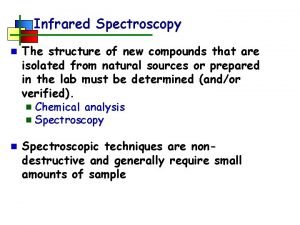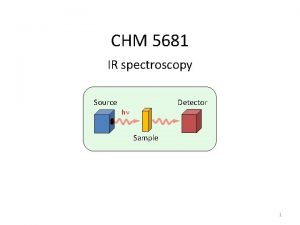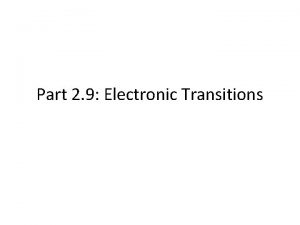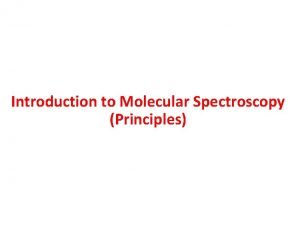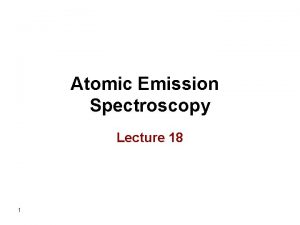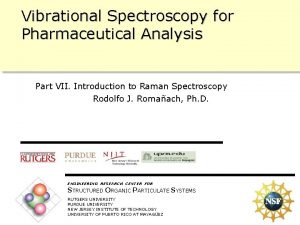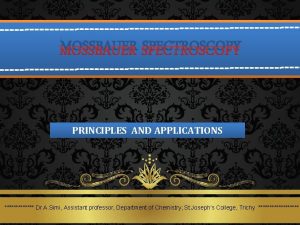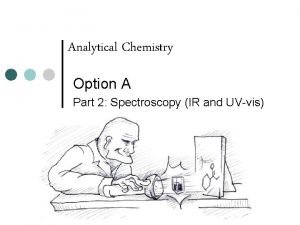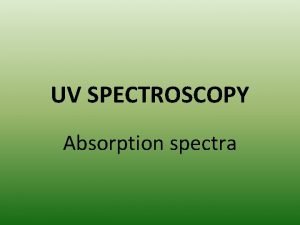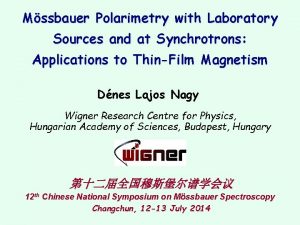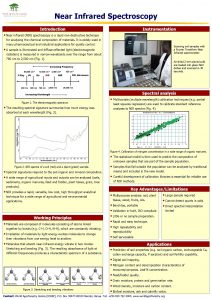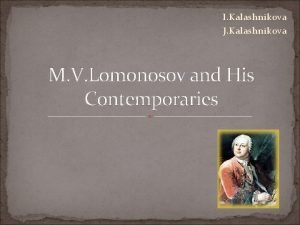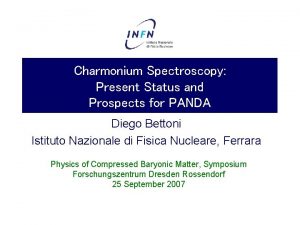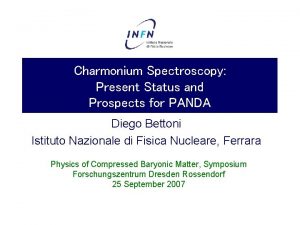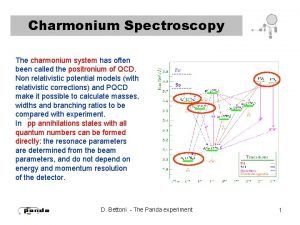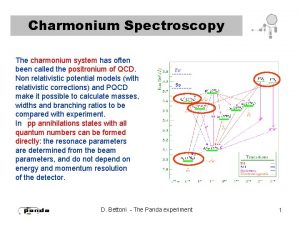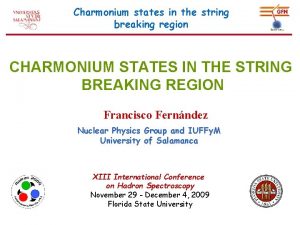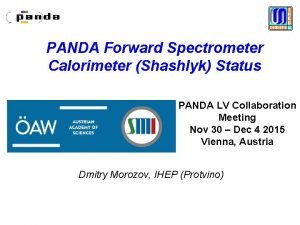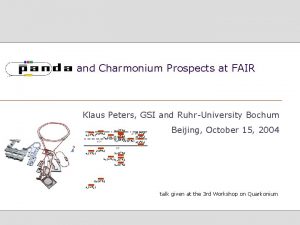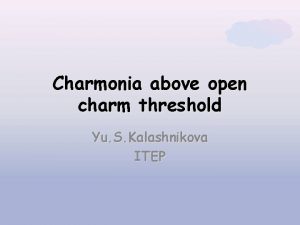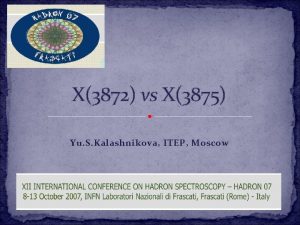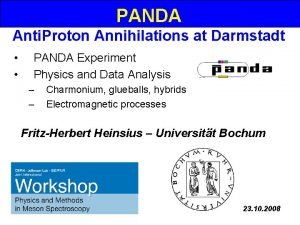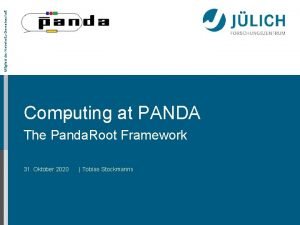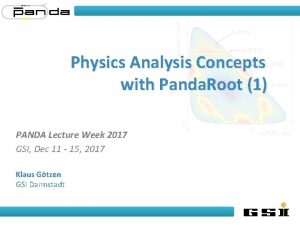Charmonium Spectroscopy Modern Status Yu S Kalashnikova PANDA
























- Slides: 24

Charmonium Spectroscopy: Modern Status Yu. S. Kalashnikova PANDA Meeting October 22 ITEP

Charmonium mc = 1. 5 Ge. V Yu. S. Kalashnikova, ITEP 2

Theory: Godfrey-Isgur M, Me. V 4250 Expected 4000 ? ? 3750 DD 3500 3250 3000 0 -+ 1 -- 0++ 1++ 2++ 1+- Yu. S. Kalashnikova, ITEP 2 -- 3 -- 2 -+ 3

c’ (21 S 0) M = 3637 4 Me. V Ba. R KSK CLEO KSK Yu. S. Kalashnikova, ITEP 4

hc(11 P 1) M = 3525. 93 0. 27 Me. V CLEO Yu. S. Kalashnikova, ITEP (2 S) -> 0 hc 5

Charmonium Zoo Experiment Belle, Ba. Bar, CDF, D 0 Belle, Ba. Bar Belle State Production mechanism X(3872) B -> K decay, pp Z(3930) Y(3940) B -> K decay X(3940) double charmonium Belle Y(4008) B -> K decay Belle Y(4160) double charmonium Ba. Bar, BES Y(4175) ISR Ba. Bar, CLEO, Belle Y(4260) ISR Ba. Bar, Belle Y(4350) Belle Y(4620) ISR Belle Z(4430) B -> K decay Belle Z(4050) B -> K decay Belle Yu. S. Kalashnikova, ITEP Z(4250) B -> K decay 6

Ø X(3872) threshold effect, tetraquark Ø Y(4260) hybrid, threshold effect, tetraquark Ø Y(4325) hybrid, threshold effect, tetraquark Ø Z(3930) 23 P 2 charmonium Ø Z(4430)+ Ø tetraquarks, hadrocharmonia Z(4050)+ Ø Z(4250)+ Yu. S. Kalashnikova, ITEP 7

Z(3930) The mass is 50 – 80 Me. V smaller than predicted for 23 P 2 Yu. S. Kalashnikova, ITEP 8

X(3872) Isospin mixture Ø + - J/ ( J/ ) Br(B->KX)Br(X-> + - J/ )=(1. 14± 0. 2)10 -5 Ø + - 0 J/ ( J/ ) Br(X-> + - 0 J/ )/Br(X-> + - J/ )=1. 0± 0. 4± 0. 3 Ø J/ Br(X-> J/ )/ Br(X-> + - J/ )=0. 14± 0. 5 Ø < 2. 3 Me. V Ø JPC = 1++ (2 -+ is not excluded) Yu. S. Kalashnikova, ITEP 9

PDG MX 3872: 3871. 2 ± 0. 5 Me. V PDG 06: m. D 0+ m. D*0 = 3871. 1 ± 0. 8 Me. V CLEO 3871. 7 ± 0. 4 Me. V hep-ex/0701016 Average for threshold: 3871. 6 ± 0. 4 Me. V m. D 0 + m. D*0 – m. X = 0. 4 0. 6 Me. V Yu. S. Kalashnikova, ITEP 10

X(3872) in J/ : (testing tetraquark hypothesis) No charged partners in B-> K (J/ - 0) Yu. S. Kalashnikova, ITEP 11

Yu. S. Kalashnikova, ITEP 12

X(3872) in D 0 D*0 (new Belle) M(BW) = 3872. 6+0. 5 -0. 4 Me. V (BW) = 3. 9+2. 5 -1. 3+0. 5 -0. 3 Me. V 2 lower than Ba. Bar and prev. Belle Yu. S. Kalashnikova, ITEP 13

What is X(3872)? Ø D 0 D*0 molecule/virtual state (what is the nature of attraction? ) Ø Tetraquark (where are charged partners? ) Ø Conventional 23 P 1 charmonium (why is it so light? ) How many X’s are there? Yu. S. Kalashnikova, ITEP 14

Yu. S. Kalashnikova, ITEP 15

What are vector Ys? Ø Conventional 1 -- charmonia (misplaced? ) Ø Tertaquarks Ø Vector hybrids Ø Threshold effects: M(DD 1)=4285 Me. V M(D*D 0)=4360 Me. V Yu. S. Kalashnikova, ITEP 16

Key observations: Yu. S. Kalashnikova, ITEP 17

Yu. S. Kalashnikova, ITEP 18

Y(4260) and Y(4350) are not seen in D(*) modes 1 -- ccg hybrid does not decay into D(*) M(1 -- ccg) 4400 Ge. V (Lattice + QCD string) Coupled channels DD 1 <-> h <-> D*D 0 may push the mass down? Yu. S. Kalashnikova, ITEP 19

Z+ particles: Charged charmonia: necessarily exotic! Yu. S. Kalashnikova, ITEP 20

B -> Z(4430)+K -> (2 S) +K M = 4433 4 2 Me. V = 45+18 -13+30 -13 Me. V No confirmation from Ba. Bar: Yu. S. Kalashnikova, ITEP 21

New charged states in B 0 -> Z- K+ -> c 1 -K+ Z 1(4050) M = 4051 14+20 -41 Me. V = 82+21+17 -17 -22 Me. V Z 2(4250) M = 4248+44+180 -29 -35 Me. V = 177+54+316 -39 -61 Me. V Yu. S. Kalashnikova, ITEP 22

What are charged Zs? Ø Tetraquark states Ø Strong charmonium-pion interaction Ø Threshold effect: Z(4430) vs D*D 1@4430 Me. V Z 1(4050) vs D*D*@4020 Me. V Z 2(4250) vs DD 1@4285 Me. V Yu. S. Kalashnikova, ITEP 23

Conclusions: Ø New charmonia are exciting! Ø New era has become possible due to B-factories Ø However, number of events is tiny (compare tens of X(3872) events @ Belle+Ba. Bar to hundreds of X(3872) events @ CDF +D 0) Ø Missing D-wave states are not found PANDA: great expectations Yu. S. Kalashnikova, ITEP 24
 Minecraft charmonium
Minecraft charmonium Symmetric top molecules ppt
Symmetric top molecules ppt Gross selection rule for rotational spectroscopy
Gross selection rule for rotational spectroscopy Difference between atomic and molecular spectroscopy
Difference between atomic and molecular spectroscopy Characterzation def
Characterzation def Selection rules for raman spectroscopy
Selection rules for raman spectroscopy Spectroscopy
Spectroscopy Spatially resolved acoustic spectroscopy
Spatially resolved acoustic spectroscopy Atomic absorption spectroscopy history
Atomic absorption spectroscopy history Stretching and bending vibrations in ir spectroscopy
Stretching and bending vibrations in ir spectroscopy Difference between ir and raman spectroscopy
Difference between ir and raman spectroscopy Ir spectroscopy table
Ir spectroscopy table Dispersive ir spectroscopy
Dispersive ir spectroscopy Infrared spectroscopy theory
Infrared spectroscopy theory Laporte selection rule is not affecting
Laporte selection rule is not affecting Applications of uv spectroscopy
Applications of uv spectroscopy Erzeng xue
Erzeng xue Selection rule for electronic transition
Selection rule for electronic transition Photometry
Photometry Raman spectroscopy disadvantages
Raman spectroscopy disadvantages Mössbauer spectroscopy principle
Mössbauer spectroscopy principle Beer lambert law in uv spectroscopy
Beer lambert law in uv spectroscopy Auxocromo
Auxocromo Mossbauer spectroscopy
Mossbauer spectroscopy Near infrared spectroscopy instrumentation
Near infrared spectroscopy instrumentation
